RARE 19th c. Primitive Antique African American Black Folk Art Quilt, WOW

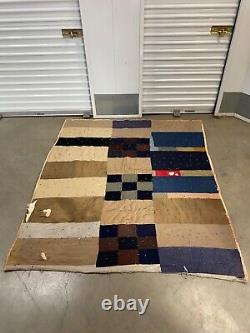



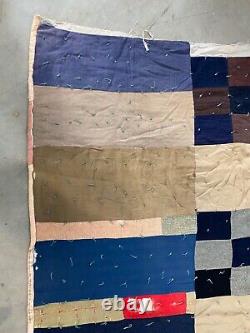
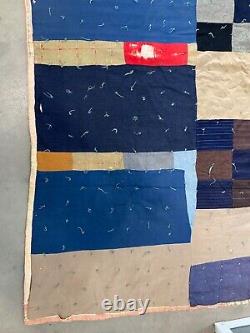


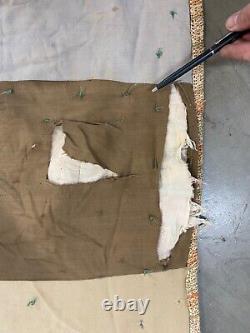
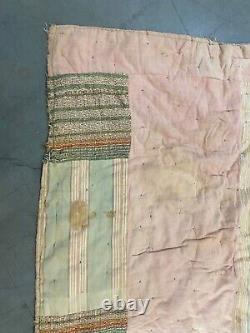


This is a visually striking and historically important RARE 19th c. Primitive Antique African American Black Folk Art Quilt, comprised of various patches of wool, cotton, calico, etc. This quilt follows the African American tradition of quilting, with an asymmetrical design plan, large shapes and strong colors, and of course improvisation and irregular borders throughout. If you clicked on this listing, you could probably recognize this quilt from a mile away like I can. This artwork likely dates to the 1880's - 1890's based on the material, wear, and patina throughout.
Approximately 66 x 78 inches. Good condition or 100+ years of age, with a few small rips, tears, loose threads, and spots of soiling, etc. It is very old, was well used, and loved for generations and this is what will happen to any genuine old quilt please see photos.This quilt came out of an old estate collection, that had previously belonged to an African American family in Los Angeles, California. There were old family photos, and other items at the home that verified this. I believe this quilt originated in the American South and traveled here with the family to Los Angeles during the "Great Migration" spurred by World War I. If you like what you see, I encourage you to make an Offer.
Please check out my other listings for mroe wonderful and unique artworks! The textile traditions of African peoples are less thoroughly documented than other aspects of folk art such as music, dance, or speech.However what is known can be traced back to the prominent influences of. Four civilizations of Central and West Africa: the Mande-speaking peoples (in the modern countries of Guinea, Mali, Senegal, and Burkino Faso); the Yoruba and Fon peoples (in the Republic of Benin and Nigeria); the Ejagham peoples (in Nigeria and Cameroons); and the Kongo peoples (in Zaire and Angola). As slaves, and also their textiles, were traded heavily throughout the Caribbean, Central America, and the Southern United States, the traditions of each distinct region became intermixed. Thus by the time that early African American quilting became a tradition in and of itself, it was already a combination of textile traditions. The segments that follow are an overview of the general themes and patterns of quilting that have been influenced by African aesthetic, religious, and cultural traditions.
Originally in Africa most of the textiles, like that displayed here, were made by men. Yet when slaves were brought to the United States their work was divided according to Western patriarchal standards and women took over the tradition. However, this strong tradition of weaving left a visible mark on African American quilting. As seen here, the use of strips, reminiscent of the strips of reed and fabric used in men's traditional weave, are used in fabric quilting. LARGE SHAPES & STRONG COLORS.
In Africa, the need to be able to recognize people from far distances was crucial for waring tribes and traveling hunting parties. This textile tradition of using large shapes and bright color was thus carried on, as exhibited in the quilt to the left. Traditional African weave was not regulated by specific pattern. The creator of the weave was free to change and alternate the pattern.
The goal of the work was to create a large fabric of separate weaves sown together rather than one repeating pattern. The ability to recreate and change old patterns was especially important to many African tribes. A break in a pattern symbolized a rebirth in the ancestral power of the creator or wearer.
And a break in a pattern also helped keep evil spirits away. Evil is believed to travel in straight lines and a break in a pattern or line confuses the spirits and slows them down.This tradition is highly recognizable in African American improvisation of European American patterns. Often in African textiles, the number of patterns or changes in pattern of a specific cloth directly correlated to the owner's status. This tradition was thus especially important for royalty and priests -- it conveyed prestige, power, status, and wealth.
The traditions of improvisation and multiple patterning also protect the quilter from anyone copying their quilts. These traditions allow for a strong sense of ownership and creativity. He quilt on the right is titled Black family Album (1854). Representative of her black family's traditions, heritage, and lineage, its creator used the technique of applique to literally paste her family album onto a lasting fabric. This technique is very common in African tribes as well as continuing on to early American traditions.It is a lasting way to record family events such as birth, marriage, geographical location, and spiritual dedication. On the left is a quilt made in 1938 that display's the same type of cultural information about the creator's family and plantation life. Very prominent in African textile tradition in the use of the diamond pattern. The diamond is symbolic of the cycles of life.
Each point represents a stage in life: birth, life, death, and rebirth. The circle shape is similarly representative of this cycle. Also used in African textiles is protective script, either in native language or symbol, or more recently in English.
The words and symbols stitched in to the patterns are sacred and protective in that they convey the knowledge, power, and intelligence of the quilt creator and wearer. During slavery years, members of the Underground Railroad would use quilts to send messages. Log Cabin quilts made with black cloth were hung to mark a safe house of refuge. Some quilts marked escape routes out of a plantation or county, others marked the stars that would act as a night-time map through the country to freedom.Charms are used in many African and African American religious societies. They are created by a priest or conjure woman for the specific needs of its user. Charms can heal or ward off evil spirits. The quilt above, with its applique men, could be used similarly to the African American Vodun dolls -- safe guarding the user from evil spirits of a specific threat. This item is in the category "Antiques\Primitives".
The seller is "willsusa_utzeqm" and is located in this country: US. This item can be shipped to United States, Canada.- Size Type/Largest Dimension: Large (Greater than 30in.)
- Type: Quilt
- Signed: Unsigned
- Color: Multi-Color
- Date of Creation: 1800-1899
- Original/Reproduction: Original
- Style: Black Folk Art
- Material: Fabric
- Region of Origin: US-Southeast

